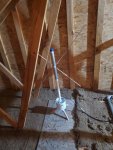rbritton1201
Captain1201
- Joined
- Jul 27, 2020
- Messages
- 407
- Reaction score
- 81
I erected the new DPD Productions Omni-X antenna in my attic, used the same cable I had connected to the Comet Discone antenna, RG8/U coax. I used a barrel connector to convert the N-style connector supplied with the antenna to a standard SO-239 connection, so I could simply connect the existing PL-259 on the end of the RG8/U coax to the antenna lead without having to change the connector provided with the antenna from N-style to a SO-239 connection. There are virtually no connection line losses. The N-style connector is preferable if erecting the antenna outside because they do seal better, etc...But, since the antenna is in my attic, I didn't see any reason to complicate things by changing out the N-Style connector to an SO-239. The connection is inside the attic, and doesn't need the weather resistance that an outside connection might need.
Previously, via the Comet Discone antenna, I was getting about one bar of signal, maximum, when receiving P25 simulcast signals off of the system located about 35 miles to the North from my QTH. Now, using the DPD Productions Omni-X antenna, IN MY ATTIC, it consistently yields the maximum signal indicator performance on the scanner's readout. There is a slight fluctuation of signal as the scanner scans over strategically located tower sites throughout that County to the North, some tower sites closer to me, and some further away. The furthest tower sites yield three or four bars of signal, and the closer tower sites yield a full five bars of signal reception on the readout. It doesn't really matter which towers the scanner receives, as they are Simulcast transmissions, so if you receive five bars of signal from even one of the towers, that's all you need with respect to excellent reception quality. The signals it receives on VHF/UHF are excellent as well. What I notice is that it's pulling in signals on VHF/UHF from further out than the Comet Discone Antenna from agencies I could not receive before.
Below is a photo of the Omni-X antenna in my attic. I mounted the antenna in a Christmas Tree Stand, and have the axis of the antenna's array oriented toward the North/South, where the County whose signals I'm trying to improve upon is located. I did test the directional characteristics of the antenna, orienting the array in various positions, and moving it around the attic in various locations. Some areas of the attic have more of what I suspected might interfere with reception, and those area were avoided, such as areas with electrical wiring, other antennas, etc...The axis of the antenna located toward the North was the most effective at improving the signal indicators on the scanner readout. With the axis of the antenna oriented to the East/West still yielded three to four bars of signal on the readout but North/South was the best performance.


Had the performance of the Omni-X not been as stellar as it is, I was considering moving the antenna outside onto a mast extension I have on my HF rotatable dipole. But now, getting five bars of signal strength, why expose the antenna to undue wear and tear from the weather? I see no reason whatsoever to move it.
Previously, via the Comet Discone antenna, I was getting about one bar of signal, maximum, when receiving P25 simulcast signals off of the system located about 35 miles to the North from my QTH. Now, using the DPD Productions Omni-X antenna, IN MY ATTIC, it consistently yields the maximum signal indicator performance on the scanner's readout. There is a slight fluctuation of signal as the scanner scans over strategically located tower sites throughout that County to the North, some tower sites closer to me, and some further away. The furthest tower sites yield three or four bars of signal, and the closer tower sites yield a full five bars of signal reception on the readout. It doesn't really matter which towers the scanner receives, as they are Simulcast transmissions, so if you receive five bars of signal from even one of the towers, that's all you need with respect to excellent reception quality. The signals it receives on VHF/UHF are excellent as well. What I notice is that it's pulling in signals on VHF/UHF from further out than the Comet Discone Antenna from agencies I could not receive before.
Below is a photo of the Omni-X antenna in my attic. I mounted the antenna in a Christmas Tree Stand, and have the axis of the antenna's array oriented toward the North/South, where the County whose signals I'm trying to improve upon is located. I did test the directional characteristics of the antenna, orienting the array in various positions, and moving it around the attic in various locations. Some areas of the attic have more of what I suspected might interfere with reception, and those area were avoided, such as areas with electrical wiring, other antennas, etc...The axis of the antenna located toward the North was the most effective at improving the signal indicators on the scanner readout. With the axis of the antenna oriented to the East/West still yielded three to four bars of signal on the readout but North/South was the best performance.


Had the performance of the Omni-X not been as stellar as it is, I was considering moving the antenna outside onto a mast extension I have on my HF rotatable dipole. But now, getting five bars of signal strength, why expose the antenna to undue wear and tear from the weather? I see no reason whatsoever to move it.
Last edited:

